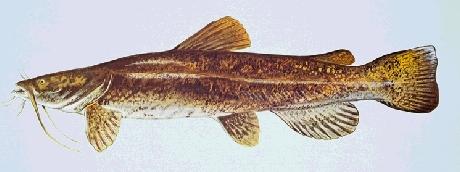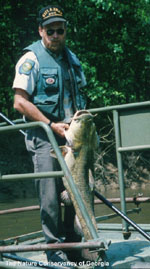|
Flathead
Catfish Pylodictus
olivaris

 Flathead
catfish are typically pale yellow to light brown on the back and
sides, and highly mottled with black and/or brown. The belly is
usually pale yellow or cream colored. The head is broadly flattened,
with a projecting lower jaw. The tail fin is only slightly notched,
not deeply forked as is the case with blue and channel catfish.
Young fish may be very dark, almost black in appearance. Flathead
catfish are typically pale yellow to light brown on the back and
sides, and highly mottled with black and/or brown. The belly is
usually pale yellow or cream colored. The head is broadly flattened,
with a projecting lower jaw. The tail fin is only slightly notched,
not deeply forked as is the case with blue and channel catfish.
Young fish may be very dark, almost black in appearance.
The
native range includes a broad area west of the Appalachian Mountains
encompassing large rivers of the Mississippi, Missouri, and Ohio
basins. The range extends as far north as North Dakota, as far west
as New Mexico, and south to the Gulf including eastern Mexico.
Fishermen
began catching flatheads in the Ocmulgee River near Macon in the
early 1970s. Since then, they have spread down the Ocmulgee and
Altamaha rivers and upstream on the Oconee River to the Lake Sinclair
dam at Milledgeville. Voracious feeders, flatheads have decimated
the populations of redbreast sunfish, and have almost wiped out
the bullhead catfish.
In
1988, state researchers caught an average of 44 pounds of flathead
catfish an hour on the Altamaha River; in 1996, that average was
594 pounds, at an average of 8 pounds per fish. In 1988, researchers
caught an average of 105 redbreast sunfish an hour on the Altamaha
compared with 1996 when they averaged 70 per hour.
|

